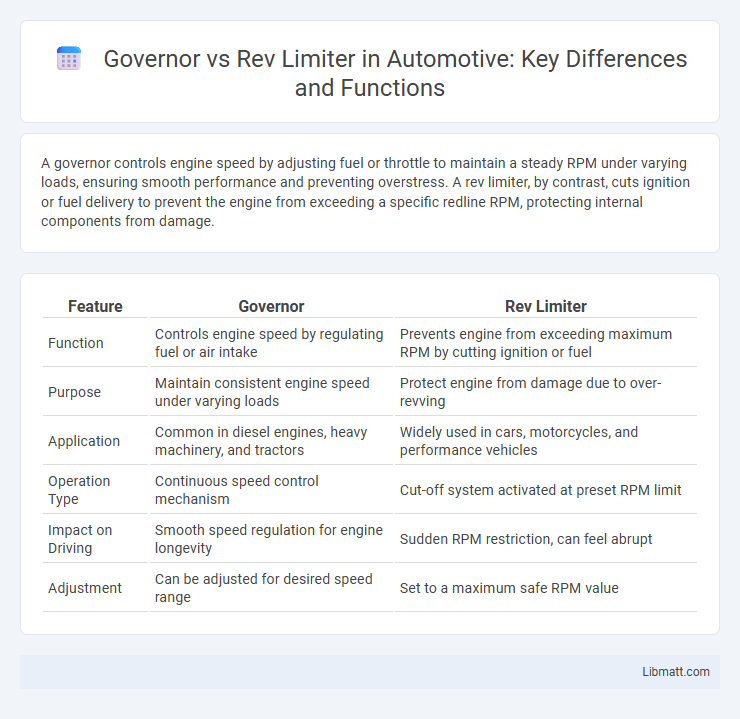A governor controls engine speed by adjusting fuel or throttle to maintain a steady RPM under varying loads, ensuring smooth performance and preventing overstress. A rev limiter, by contrast, cuts ignition or fuel delivery to prevent the engine from exceeding a specific redline RPM, protecting internal components from damage.
Table of Comparison
| Feature | Governor | Rev Limiter |
|---|---|---|
| Function | Controls engine speed by regulating fuel or air intake | Prevents engine from exceeding maximum RPM by cutting ignition or fuel |
| Purpose | Maintain consistent engine speed under varying loads | Protect engine from damage due to over-revving |
| Application | Common in diesel engines, heavy machinery, and tractors | Widely used in cars, motorcycles, and performance vehicles |
| Operation Type | Continuous speed control mechanism | Cut-off system activated at preset RPM limit |
| Impact on Driving | Smooth speed regulation for engine longevity | Sudden RPM restriction, can feel abrupt |
| Adjustment | Can be adjusted for desired speed range | Set to a maximum safe RPM value |
Introduction to Engine Speed Control Mechanisms
Engine speed control mechanisms manage the rotational speed of an engine to ensure optimal performance and prevent damage. A governor automatically adjusts fuel or ignition timing to maintain a set speed under varying loads, while a rev limiter restricts maximum engine RPM by cutting fuel or spark to avoid over-revving. Understanding these systems helps you protect your engine and maintain efficient operation.
What is a Governor?
A governor is a mechanical or electronic device that controls the maximum speed of an engine by regulating fuel or energy input, preventing it from exceeding safe operational limits. Unlike a rev limiter that cuts ignition or fuel supply abruptly at a set RPM, a governor continuously adjusts engine speed to maintain steady performance under varying loads. Your engine benefits from a governor by achieving smoother control and protecting internal components from damage caused by overspeeding.
Types of Governors: Mechanical and Electronic
Mechanical governors regulate engine speed by using rotating weights that adjust fuel delivery based on centrifugal force, providing a direct and durable method for speed control. Electronic governors utilize sensors and microprocessors to accurately manage engine speed through precise adjustments to fuel injection or throttle position, offering improved responsiveness and efficiency. Both types serve to prevent engine overspeed, but electronic governors enable more sophisticated and adaptable control compared to traditional mechanical systems.
What is a Rev Limiter?
A rev limiter is an electronic or mechanical device designed to prevent an engine from exceeding its maximum safe RPM (revolutions per minute) by cutting fuel or spark. Unlike a governor, which regulates engine speed to maintain a set RPM under varying loads, a rev limiter acts as a protective measure to avoid engine damage during aggressive acceleration. Understanding how your rev limiter works ensures better engine longevity and performance control.
How Rev Limiters Work in Modern Engines
Rev limiters in modern engines control maximum RPM by electronically cutting fuel or spark to prevent engine damage, ensuring optimal performance and longevity. Unlike mechanical governors that regulate speed through physical linkage, rev limiters use engine control units (ECUs) to precisely monitor and manage engine revolutions. Your vehicle's ECU continuously measures RPM and activates the rev limiter to maintain engine safety within predefined limits.
Core Differences Between Governors and Rev Limiters
Governors control engine speed by adjusting fuel or power input to maintain a set RPM, ensuring smooth operation under varying loads, while rev limiters actively cut fuel or ignition to prevent the engine from exceeding a maximum RPM, protecting against damage. Governors provide continuous speed regulation, ideal for engines in industrial or marine applications, whereas rev limiters serve as safety devices in automotive engines to avoid over-revving. The core difference lies in the governors' role in maintaining speed stability versus rev limiters' function in enforcing a hard RPM ceiling.
Advantages and Disadvantages of Governors
Governors provide precise engine speed control by adjusting fuel or throttle input to maintain a set RPM, enhancing safety and preventing engine damage from overspeeding. Their mechanical or electronic designs offer reliability and smooth operation across various applications but may introduce complexity and cost compared to simpler rev limiters. However, governors can reduce engine responsiveness under rapid load changes, limiting performance flexibility in high-demand scenarios.
Benefits and Drawbacks of Rev Limiters
Rev limiters protect your engine by preventing it from exceeding safe RPM levels, reducing the risk of mechanical damage and improving engine longevity. However, they can occasionally cause abrupt power cuts that may disrupt smooth acceleration or cause hesitation in performance driving. Understanding these benefits and drawbacks helps you balance engine safety with optimal performance.
Applications: When to Use Governors vs Rev Limiters
Governors are ideal for applications requiring precise engine speed control under varying loads, such as generators, heavy machinery, and industrial engines, ensuring consistent performance and fuel efficiency. Rev limiters are designed primarily for automotive and racing engines to prevent engine damage by capping maximum RPM during aggressive acceleration or high-speed operation. Selecting between a governor and a rev limiter depends on whether maintaining steady speed or protecting engine components from overspeed is the primary goal.
Choosing the Right System for Engine Protection
Choosing the right system for engine protection depends on understanding the distinct functions of a governor and a rev limiter. A governor automatically regulates engine speed to prevent overload by maintaining it within safe limits during continuous operation, ideal for heavy machinery and generators. Your decision should consider whether precise speed control or peak RPM restriction suits your engine's operational demands best.
governor vs rev limiter Infographic

 libmatt.com
libmatt.com